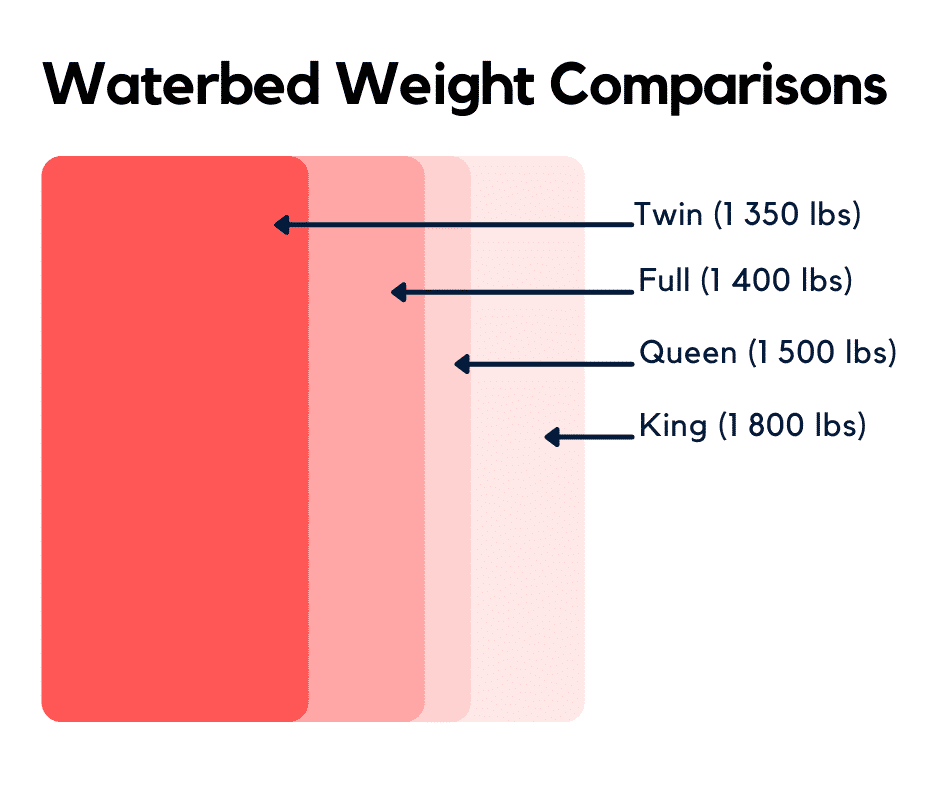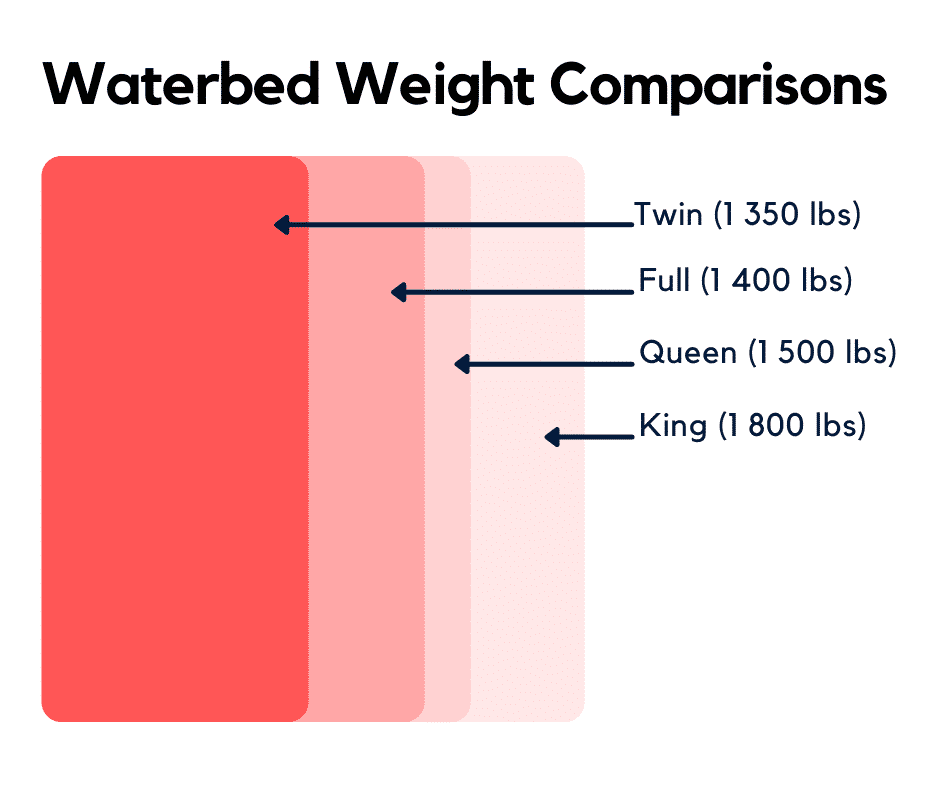A water bed is one of the most comfortable types of beds available on the market due to the pleasant buoyant feeling and the excellent medical features it offers. Compared to when it was first designed for medical purposes, the waterbed has become quite a popular alternative to ordinary beds. Waterbeds can help to alleviate pressure on the back and joints, reduce pain, and improve the quality of your sleep, but they are heavy and there have been concerns that they could cause the floor to collapse. So, should you use a waterbed on the second floor? This article will put your concerns to rest.
A waterbed can be used on the second floor if the building is less than 100 years old and the weight limit of the floor is at least 40 pounds per square foot.
Although waterbeds are a great type of bed, there is much controversy around using them in apartment buildings—especially on the second floor. Many building owners may consider using waterbeds illegal while others accept them under certain conditions and require waterbed liability insurance. Our article about waterbed liability insurance covers everything you need to know about purchasing this type of insurance cover.
Can A Second Floor Collapse Due to the Weight of a Waterbed?
Unfortunately, a second-floor can collapse because of the weight of a waterbed, though other factors will also contribute to this. Buildings are designed with a maximum floor load that should not be exceeded. Although there are no reported floor collapse accidents related to waterbeds according to this article in the Chicago Tribune, the possibility still exists that a floor holding a waterbed could cave in. These accidents can be avoided by ensuring the building you want to use your waterbed in is designed for such loads in addition to making sure to choose a suitable bed size and weight.
The second floor can collapse if it does not meet building regulatory specifications. Ensure that the second floor of the building can support the weight of a waterbed.
A collapsed floor may be unrelated to the weight of the bed, but it could be connected to water damage from leaks. Collapsed ceilings that are the result of water damage are quite common in apartments according to this article from WaterDamagePlus.com. Since waterbeds have the potential for leaks, they can cause a second floor to deteriorate and collapse regardless of their weight.
How Much Weight Can A Second Floor Hold?
Buildings cannot be built haphazardly and there are specific regulations and codes that govern the construction of buildings to ensure that their load capacity is suitable for the purposes for which they are built. The codes that govern building regulations are referred to as the international residential codes.
The weight a second floor can hold varies from building to building. The average building built after 1950 can support 40 lb per square foot on the second floor. However, buildings built earlier than 1927 might not have this weight-bearing capacity.
According to the international residential codes, a second-floor bedroom can support up to 30 pounds per square foot of live loads. As for non-sleeping rooms, the floor can hold up to 40 pounds per square foot for live loads. Since 1927 when the first code that governs construction was issued under the name of the Uniform Building Code, most buildings were built following the same codes for floor loads as those built following the international residential codes. The floor load capacity of buildings has not changed much since then. However, for buildings built before the introduction of construction codes, their load-bearing capacity may be considerably less.

How Much Does A Waterbed Weigh?
The reason why waterbeds can be problematic is that they are very heavy and vary in weight according to size and type. The bigger the bed is, the heavier it is. A hard-side king-size waterbed can weigh approximately 1800 pounds, a queen-size waterbed can weigh around 1500 pounds, a full-size waterbed can weigh 1400 pounds, and a twin-size waterbed can weigh 1350 pounds. This includes the 300 pounds of the bed’s wooden frame. Softside waterbeds can be half the weight of a hard side waterbed for each corresponding size.
A waterbed can weigh between 1350 and 2000 pounds. A twin-size waterbed weighs about 1350 pounds, a full-size waterbed weighs about 1400 pounds, a queen-size waterbed weighs about 1500 pounds and a king-size waterbed around 1800 pounds. The collective weight-bearing capacity of the second floor should be at least 2000 pounds more than the weight of the waterbed.
One important element you need to consider is that the capacity of the floor includes the weight of the occupants and furniture, so the weight of a waterbed is not the only factor to evaluate. The weight capacity must exceed the weight of the waterbed because the occupants and other furniture will add to the load. Also, keep in mind that the load capacity is calculated per square foot. The weight of the waterbed is distributed over a large area of the floor and not concentrated on one spot.

How to Choose a Waterbed or Waterbed Alternative for The Second Floor
If you want to use a waterbed on the second floor of your home or apartment building, it would be best to ensure that you take all necessary precautions to avoid leaks that could cause water damage.
When choosing a waterbed for use in a second-floor apartment, buy a waterbed that is made from puncture-resistant materials along with suitable waterbed liability insurance.
If your apartment landlord forbids the use of waterbeds in the building then rather buy a memory foam mattress that offers excellent support as we discuss in our memory foam mattress shopping guide or an air mattress that provides adjustable firmness and portability as discussed in our air bed costs guide.
1. Choose a Waterbed Made of Puncture Resistant Materials
For a waterbed to be used safely on the second floor, it is important to avoid leaks that could result in water damage. Choose a waterbed mattress that is puncture-resistant, place a waterbed liner on the bed frame, and avoid placing any sharp objects on the waterbed mattress. Our waterbed maintenance guidelines highlight many ways to properly care for a waterbed.
Additionally, you may want to take a look at our article explaining common waterbed issues and how to fix them.
2. Buy Waterbed Insurance
If the landlord or apartment building manager allows the use of waterbeds then it’s a good idea to purchase additional waterbed liability insurance to safeguard yourself against any claims that may result from waterbed-related accidents. Our guide to waterbed costs covers all the hidden and obvious costs related to waterbeds, including insurance, and will give you a complete overview of all the expenses that you may incur.
Be sure to also take a look at our related article that answers more questions like, “do you need a mattress for a waterbed?” and many more.
3. Air beds and Memory Foam Mattresses Are Lighter Alternatives to Waterbeds
A comparable alternative to a waterbed is an air bed. People love waterbeds because of the buoyant feeling that they provide. Air mattresses, like this one, can provide the same weightless feeling and help reduce painful pressure points. Airbeds are easy to set up and transport, while also avoiding the possible disasters often associated with waterbeds. Our air bed benefits guide covers all the reasons why choosing an air bed might be suitable for you.
Memory foam mattresses like this are a great alternative to waterbeds as well. Memory foam is very soft and comfortable to sleep on while providing amazing medical benefits like water beds. They are ideal for reducing back pain, relieving pressure on joints, muscle tension, and preventing the sleeper from tossing and turning in bed.
With air mattresses and memory foam mattresses, you can enjoy a similar feeling to sleeping on a waterbed and simultaneously avoid the serious problems associated with using waterbeds on the second floor.
Summary of Waterbed Mattress Alternatives
| Type of Mattress | Waterbed-like Qualities | Amazon Product | Price |
| Airbed | Adjustable firmness levels | SoundAsleep Dream Series Air Mattress with ComfortCoil | ~$150 |
| Air Mattress | Inner baffles to create the same weightless feeling when sleeping | Air Mattress with Built-in Pump, Queen Size Inflatable Mattress | ~$120 |
| Gel Memory Foam | Cooling properties | Novilla Queen Size Mattress, | $360 |
| Memory Foam Mattress | Excellent support for joints | Full-Size Mattress, Molblly 10 inch Cooling-Gel Memory Foam Mattress | ~$280 |
| Memory Foam Hybrid Mattress | Medium support for comfort | Linenspa 10 Inch Memory Foam and Innerspring Hybrid | ~$170 |
Can A Bed Be Too Heavy For A Floor?
A water bed can be too heavy for the floor of an old apartment building and cause the floor to collapse. Not all buildings are designed to hold the same amount of weight. Older construction regulations were different from the construction of modern buildings, and older buildings were not designed to hold loads as heavy as the buildings of today.
A bed can be too heavy for a floor if the building is very old or if the floor has endured unnoticed termite damage. Before placing a waterbed on a second floor, make sure that the floor has the structural integrity to support the weight of the bed.
Even in modern buildings, a waterbed may be too heavy if proper building codes aren’t adhered to. If there is any damage to the floor that affects its integrity, like termite or water damage, then the floor will not be able to safely support any considerable load, be that a waterbed or any other type of heavy furniture.

